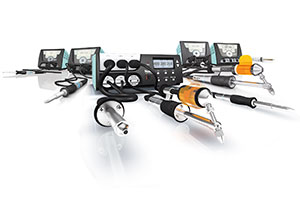Five revolutionary electronics inventions which changed the world

Ulf Timmermann, CEO of reichelt elektronik, discusses five electronics inventions which have changed the landscape of modern life… 50 years ago, a computer was still the size of a room and a team of people were required to make it work. Now, we have an array of electronic inventions at our fingertips, from smart sensors, to LEDs, to 3D printers, all fully controllable through the power of the internet. While some may have fallen by the wayside (anyone remember the fax machine?), some of the inventions of the last five decades have stood the test of time and are indispensable today. To celebrate reichelt’s half century of trading, we’ve taken a look back to give an overview of five pioneering inventions in electronics history. The battery What would the world look like without batteries? Used for powering the smallest electronics such as smartphones to something larger like an entire city, this invention was a turning point for mankind. Invented in the 1800 by Alessandro Volta (namesake of the volts unit of measurement of course), The Voltasche Column consisted of copper and zinc flakes stacked on top of each other as well as pieces of cardboard and leather saturated with electrolyte that would then conduct the current. Unfortunately, but perhaps unsurprisingly, this early version was deemed unsafe due to the hazardous materials. Now, lithium-based batteries can be found in every electrical device, powering almost all innovations since its invention. The soldering iron A must-have for DIYers and industry alike, the soldering iron has been an essential tool for creating many objects we couldn’t live without today. Although present-day soldering irons are mainly electrical, these devices used to be powered by heating coal and gas. The humble soldering iron can be traced back to the times of Egyptian Pharaohs and Trojan horses. Materials used for soldering included gold and silver, but tin was preferred as an inexpensive material. Today’s electrical soldering iron was invented in 1921, with the iron perfected over time adding new features. Now it’s found in every workshop and tool-shed around the world. The circuit board Thanks in part to the soldering iron came an invention you almost certainly have in your pocket right now. The circuit board was developed to clean up the jumbled assortment of electronic components found in devices. Before that, all components were crossed and mixed up, making a 1930s engineer’s job that much harder. In 1950, the circuit board really came into its own and gradually became smaller and smaller so it can be squeezed into any device. Now available to anyone, whether they’re in the electronics industry or a DIYer, they can be used for a variety of purposes. The Raspberry Pi for example, can be used as a personal cloud storage device, smart home device or for online security. With more developments in power and continuous shrinking in size, the possibilities of circuit boards continue to be unlocked. The digital storage oscilloscope Electrical engineers across the globe would agree the oscilloscope is an essential tool to have in the industry. Although it dates back to the early 20th century, the first digital storage oscilloscope was launched in the 1980s by New York-based manufacturer LeCroy. These digital storage oscilloscopes have overtaken their analogue predecessors due to an increased set of features, speedier performance, and larger memory. Now, they are available in a variety of price ranges for both personal and professional use, and include various functions depending on the device. The 3D printer 50 years ago, 3D printing didn’t exist. Now, it’s being used in electronics, medical technology and many other industries – not to mention all the hobbyists making products at home too. There have been many stories in the news where items and devices that are usually complex have been made using 3D printing techniques for a variety of uses. Notable examples include the making of prosthetic limbs that would usually cost substantially more than they would using a 3D printer. The development of 3D printing began in 1981 when Hideo Kodama of Nagoya Municipal Industrial Research Institute invented two additive methods for fabricating three-dimensional plastic models. This was successfully practiced in 1983 and the first 3D printer was released in 1988 to the public. Since then, the art and technology has evolved and been perfected with the devices readily available for use in a personal and professional environment. The evolution of the printer has made way for a growing number of the filaments, such as wood and chocolate, that can now be printed. What’s next for electronics? It is difficult to predict what the electronics and components landscape will look like in another 50 years’ time, and which technologies will be indispensable to the electronics industry in the long term. With continuous public and commercial interest in the ‘Internet of Things’, we will see many more connected devices that can be controlled remotely, from household appliances to vehicles. A more connected world also means bigger and more complex networks to link the devices together. The fourth industrial revolution will mean everything is connected and therefore electronic. Who knows what another 50 years of technological evolution will look like? For the team here at reichelt, we can’t wait to see what comes along next.
Designing longer lasting smart home sensors

Why long-lasting sensors are key to designing the home of the future! Home automation has been gaining traction over the past few years, with massive developments in features and relevant technologies. However, these technologies are only as effective as their power source. Here, Michele Windsor, global marketing manager at home automation battery provider Ultralife Corporation, explains the importance of having long lasting batteries at the centre of home automationproduct design. Rube Goldberg machines are a fascinating spectacle to watch, with intricate parts moving around to create a symphony of movement to perform tasks. However, to function, every single part must work perfectly, otherwise it takes a lengthy reset before the spectacle can resume. Just like in a Rube Goldberg machine, every piece in a smart house must work perfectly in order to create the spectacle that makes your life easier and more efficient. To make sure your smart house is always working, its sensors must always be working. Sensors are what feed data to the smart house, so it knows what time it is, what the temperature is, or whether the sun is glaring through your windows. Most sensors are battery powered and, as they need to be active constantly, it is important to make sure that they have batteries that are reliable and long lasting. Based on Ultralife’s experience in the sector, many sensors for smart home devices arrive on the market with CR123A model batteries. However, not all these batteries are created equal. Many are often limited in their battery capacity, which means a shorter operating life for the sensor. Design engineers can overcome this by choosing a long-lasting CR123A battery suitable for home automation sensors, such as the CR123A range of batteries produced by Ultralife. They have an improved internal spiral construction that provides a higher capacity than is currently available in similar products on the market, while remaining long lasting for home automation functions. According to data from Strategy Analytics, 38 per cent of homes in the USA will be smart homes by 2019.Because of this, it is incredibly important to set out solid design foundations now. Putting long lasting batteries into smart homes design now will avoid mass sensor outages, customer dissatisfaction and possible backlash against manufacturers in the future. Whether it be your security cameras, lights, sprinklers, or your fans, sensors keep smart devices fed with relevant information to ensure they are working precisely to maximise user comfort and convenience. In a sense, making intelligent decisions about smart homes now will allow our future selves to be awed by anintricate connected Rube Goldberg machine, performing millions of tasks simultaneously to make our lives simpler and stress free.
Powering the Military

The power requirements of military equipment differ to those of many other devices. To guide design engineers when choosing a battery for their military device, global military battery specialist, Ultralife Corporation, has published a checklist highlighting the important considerations. The checklist, which can be downloaded from Ultralife’s website, consists of five key questions that design engineers must ask themselves before choosing a battery for a military device. The answer to each question will depend on the design of the device, how it will be used and in what conditions. “Unlike most battery-powered equipment, military devices are often exposed to incredibly harsh conditions such as extreme temperatures, rough physical handling and high moisture environments,” explained Johnathan Celso, applications engineer at Ultralife. “Design engineers must choose batteries capable of withstanding these conditions. To increase a battery’s robustness, they may also need to incorporate protective structures into the design.” However, robustness isn’t the only essential consideration. The battery must power the device in accordance with the needs of the soldier. For example, some devices are required to lie dormant for long periods, but rapidly activate when needed.” The failure of a device to meet a soldier’s requirements impedes the soldier’s ability to do their job and puts their lives at risk. The earlier that design engineers consider the battery, the better the device they provide to soldiers to meet their needs. As technology advances, the possibilities to provide soldiers with high quality, beneficial equipment are increasing. For example, many military devices now use smart batteries that communicate with the user regarding information such as the state-of-charge or the need to be cooled down. This checklist should prompt design engineers to make the high level considerations before embarking on new projects. Ultralife has a long history of manufacturing batteries and chargers for the military market. To find out more about portable power solutions for military use, contact a sales representative on +1 (315) 332 7100 or +44 (0) 1782 566 622.




